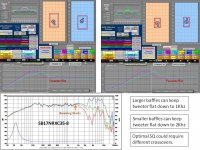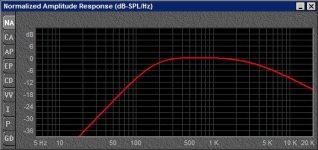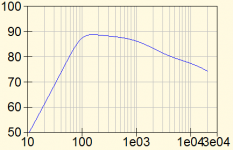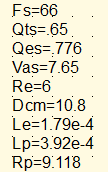Hi,
am I right that box simulators (working based on T&S parameters) do the calculation for the low frequency response but have nothing to do with the high frequency roll-off but the measured response curve (given e.g. on the data sheet) is to consider here?
I'm asking this because in simulator BassBox Pro high frequency roll-off is also calculated and it differs a lot from the measured values stated on the data sheet (roll-off starts at much lower freq. according to the simulation) so I got a bit confused if box influences high freq response, too or the low one only?
Thank you!
Péter
am I right that box simulators (working based on T&S parameters) do the calculation for the low frequency response but have nothing to do with the high frequency roll-off but the measured response curve (given e.g. on the data sheet) is to consider here?
I'm asking this because in simulator BassBox Pro high frequency roll-off is also calculated and it differs a lot from the measured values stated on the data sheet (roll-off starts at much lower freq. according to the simulation) so I got a bit confused if box influences high freq response, too or the low one only?
Thank you!
Péter
Box has little influence on high frequency roll-off. Some sims can do diffraction simulations, but for those, you have to enter dimensions of front baffle and location of driver.
Assuming that by "high frequencies", you mean those well above those that would normally be involved in the Baffle Step Loss calculus (let's say above 2000Hz?), edge diffraction and interference from grille frames, surface mounted frames for mid/bass units , etc might well be more of a concern. Of course the dispersion pattern of the high frequency drivers will come into play.
T/S sims are only good for the pistonic range of the driver, roughly 5-10 times the resonance frequency. Simulators that factor in inductance will often show a high frequency roll off that doesn't exist in reality.
The difference between the electrical roll-off calculated from the voicecoil inductance/resistance (such as BassBox, WinISD etc show) and reality is that in reality you have all the cone breakup nodes riding on top of the electrical roll-off. If cone breakup is making the frequency response increase, and the inductance is making it equally decrease then it may track roughly flat for a bit longer before beginning to roll off.
In the case of a woofer, what you want to be looking to guesstimate an in-box response is the actual measured frequency response on an infinite baffle (such as shown in the datasheet) and then a box edge diffraction sim. What you measure in reality with the driver in the box is the convolution of the infinite baffle response and the baffle edge diffraction.
In the case of a woofer, what you want to be looking to guesstimate an in-box response is the actual measured frequency response on an infinite baffle (such as shown in the datasheet) and then a box edge diffraction sim. What you measure in reality with the driver in the box is the convolution of the infinite baffle response and the baffle edge diffraction.
Hi,
Basically you can't trust box simulators to tell you anything
about the low pass roll-off of the bass driver, only the bass
alignment is likely to be accurate.
You need more advanced tools for above the bass region.
rgds, sreten.
Basically you can't trust box simulators to tell you anything
about the low pass roll-off of the bass driver, only the bass
alignment is likely to be accurate.
You need more advanced tools for above the bass region.
rgds, sreten.
It is common to locate the dome tweeter near the top/side of the cabinet, where wavelengths as low as 1000-2000Hz can be long enough to step/diffract off the top/side baffle edge. The T-M crossover design must include any necessary adjustments. During early paper design, baffle simulators allow experimental driver placements, and output a frequency response data(FRD) file that sums into the driver's big-baffle FRD file for improved accuracy on initial crossover design. After construction, real mic measurements tell the real truth for the final crossover circuit. Simple 2-way simulation attached for big/small box effect.
“BaffleDiffraction and Boundary Simulator”:
Loudspeaker Design Software
"Baffle Diffraction Simulator"
http://www.pvconsultants.com/audio/diffraction/downloadbds.htm
“BaffleDiffraction and Boundary Simulator”:
Loudspeaker Design Software
"Baffle Diffraction Simulator"
http://www.pvconsultants.com/audio/diffraction/downloadbds.htm
Attachments
Dear All,
thank you very much for your lot's of valuable responses!
It is actually clear that what simulators calculating only based on T&S parameters are not correct for high freq roll-off but for low freq response only hence their results for high freq roll-off can be disregarded and datasheet response curve can be considered as a basis plus other simulators or methods can be used for more precise calculations of the high freq response of a woofer or mid range speaker. Is this correct?
Just as an example attaching the simulation results done by BassBox and the factory datasheet of the same mid range speaker where simulator showed roll-off much earlier (only T&S and electrical parameters were used) - simulator result is not correct because of the above, right?
Thank you once more also for the additional design softwares!
Péter
thank you very much for your lot's of valuable responses!
It is actually clear that what simulators calculating only based on T&S parameters are not correct for high freq roll-off but for low freq response only hence their results for high freq roll-off can be disregarded and datasheet response curve can be considered as a basis plus other simulators or methods can be used for more precise calculations of the high freq response of a woofer or mid range speaker. Is this correct?
Just as an example attaching the simulation results done by BassBox and the factory datasheet of the same mid range speaker where simulator showed roll-off much earlier (only T&S and electrical parameters were used) - simulator result is not correct because of the above, right?
Thank you once more also for the additional design softwares!
Péter
Attachments
If I remember correctly Bassbox incorporates some form of measured high frequency data on top of the otherwise default flat response. It would be useful while setting up to know roughly what to expect, however data measured on one axis won't tell you exactly what's going on at any rate. Another consideration is that manufacturers sometimes change their designs.
Dear Allen,
this is exactly what is strange for me: correcting simulated response by measured values (which is indeed possible in BassBox) was switched off and I got the result uploaded beside this condition. So, the high freq roll-off (which is much earlier than reported by the measurements) is purely coming from the simulation w/o any correction by measured data. This is why I'm confused: does this mean that the box influences high freq response, too (simulation is correct and has to be considered in this case) or this comes from some improper simulation which delivers incorrect results for the high freq roll-off which can be disregarded and the measured values can be used instead while simulation results are relevant for the low frequency only?
Thank you,
Péter
this is exactly what is strange for me: correcting simulated response by measured values (which is indeed possible in BassBox) was switched off and I got the result uploaded beside this condition. So, the high freq roll-off (which is much earlier than reported by the measurements) is purely coming from the simulation w/o any correction by measured data. This is why I'm confused: does this mean that the box influences high freq response, too (simulation is correct and has to be considered in this case) or this comes from some improper simulation which delivers incorrect results for the high freq roll-off which can be disregarded and the measured values can be used instead while simulation results are relevant for the low frequency only?
Thank you,
Péter
I am not an authority on Bassbox but I have used it for LF box sims and take the highs as more of a guideline. The highs can be affected by the box if diffraction is simulated. If it was here, I'd expect some wiggles in the response so I'd assume it isn't.
Maybe they have considered the cone mass? Since the cone size creates output differences with directivity/lobing, and cone breakup complicates this, and this can create wiggles in the response as well, and because such information isn't well conveyed through a single response measurement, I'd take the top end as a guideline and take other measures to find out what's going on there.
Ordinarily you can look at the cone size and make an assumption on the high frequency limit. Another way to do this is to look for a cone breakup peak on the manufacturers response plot. If you go close to this end of the band expect to have to look at the problem in more detail.
Maybe they have considered the cone mass? Since the cone size creates output differences with directivity/lobing, and cone breakup complicates this, and this can create wiggles in the response as well, and because such information isn't well conveyed through a single response measurement, I'd take the top end as a guideline and take other measures to find out what's going on there.
Ordinarily you can look at the cone size and make an assumption on the high frequency limit. Another way to do this is to look for a cone breakup peak on the manufacturers response plot. If you go close to this end of the band expect to have to look at the problem in more detail.
The high frequency roll off that remains when you disable the frequency response measurement is a theoretical roll off due to the voicecoil resistance (Re) and inductance (Le) T/S parameters.
Thanks for your responses,
Dear TMM,
you say it is coming from electrical parameters and that it is "theoretical" so this means that it is not necessarily there in the reality (depending on the electrical environment around I guess)?
Thank you!
Péter
Dear TMM,
you say it is coming from electrical parameters and that it is "theoretical" so this means that it is not necessarily there in the reality (depending on the electrical environment around I guess)?
Thank you!
Péter
It assumes that the speaker cone does not break up. In reality the cone does break up so the roll off will be higher in frequency and not smooth.Thanks for your responses,
Dear TMM,
you say it is coming from electrical parameters and that it is "theoretical" so this means that it is not necessarily there in the reality (depending on the electrical environment around I guess)?
Thank you!
Péter
Sent from my Nexus 5 using Tapatalk
As wavelengths become smaller, beaming sets in. Outer parts of the cone may become a horn for the inner parts, so amplifying on-axis level.
you say it is coming from electrical parameters and that it is "theoretical" so this means that it is not necessarily there in the reality?
Here is the simulated response of a 5" woofer in a sealed box (7.7L) with and without the actual measured inductance factored in. The actual measured frequency response is reasonably flat until 10kHz.
I don't know what you are stuck on. The assumptions made in making a T/S modeler are such that it is not valid at high frequencies.
Bassbox doesn't have any "magic sauce" that makes it better than other sims.
Attachments
I think I got it finally - what sim (e.g. BassBox) takes into account is the effect of the electrical parameters but doesn't do it with other contributors like break up thus it reports roll off at significantly lower frequencies than measuremenst published by e.g. the manufacturer of the speaker (typically measured in standard IEC board). Measurement incorporates all the effects by nature thus it gives the real response at higher frequences not the simulation (only sorrounding electrical parameters like that of the amp can have an effect on it but not the box itself).
Dear Ron E,
I didn't think BassBox has anything more than other sims but simply got confused by the huge difference of its simulated results and measured curves in high frequences and wanted to understood whether the box has any effect here but it's clear now.
Thank you all!
Péter
Dear Ron E,
I didn't think BassBox has anything more than other sims but simply got confused by the huge difference of its simulated results and measured curves in high frequences and wanted to understood whether the box has any effect here but it's clear now.
Thank you all!
Péter
One more comment for the above: I made a try and set the inductance parameter of the speaker to 0 mH and BassBox calculated infinite high freq response so no roll off at all thus now I'm convinced that as it was guessed it calculated it based on the electrical parameters only but nothing t do with the box itself.
Péter
Péter
I agree wholeheartedly with TMM and AllenB. Regarding BassBoxPro, it simulates HF roll-off using ONLY the voice coil inductance. I've always wondered why they didn't include diaphragm mass as that's calculated in the parameters.
Regarding cone breakup, you fellas are two of the very few and I do mean very few whom I've met over the last 4 or so decades that are aware of such phenomena.
I've recently uploaded a page into my website on that very subject. Actually, while it was considered for many years, this discussion was the trigger to complete the task. It can be found here in the link provided below at the bottom of the list. It is too lengthy to place here and having it in the website makes it convenient for easy future access, if necessary.
http://www.ln271828.net/p3.htm
Any and all comments and corrections are welcome.
Robert
Regarding cone breakup, you fellas are two of the very few and I do mean very few whom I've met over the last 4 or so decades that are aware of such phenomena.
I've recently uploaded a page into my website on that very subject. Actually, while it was considered for many years, this discussion was the trigger to complete the task. It can be found here in the link provided below at the bottom of the list. It is too lengthy to place here and having it in the website makes it convenient for easy future access, if necessary.
http://www.ln271828.net/p3.htm
Any and all comments and corrections are welcome.
Robert
- Status
- Not open for further replies.
- Home
- Loudspeakers
- Multi-Way
- high frequency response in box?




